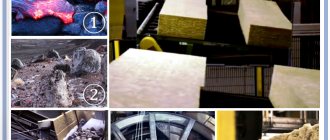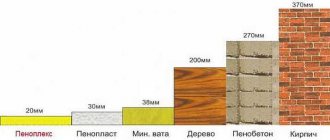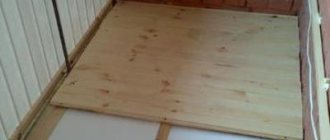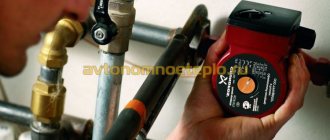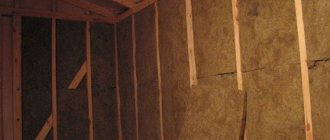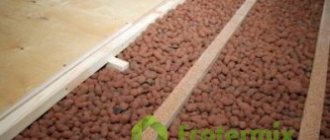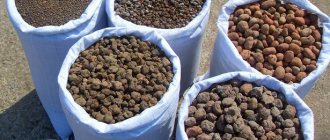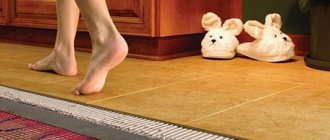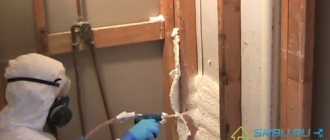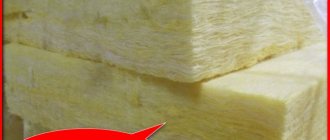Necessary equipment
Penoizol is a cellular type foam plastic (expanded polystyrene) based on urea. Urea resin is used in a foamed state, and the addition of foamed water and a hardener produces an air-filled polymer. Penoizol insulation is manufactured directly at the construction site . The entire insulation process is conventionally divided into 3 stages - pouring the liquid mass into the formed void (inter-wall or inter-block layer, special formwork), polymerization and hardening of the polymer .
Filling of liquid raw materials is ensured using a filling hose of special equipment. The pouring machine consists of containers for water, resin and hardener, from which the components flow through hoses into the mixing chamber. Air is supplied there with the help of a compressor, which ensures foaming of the mass. Then the foamed liquid mass flows through the hose directly to the area that needs to be insulated.
A high-quality polymer will be obtained with proper process control. For this purpose, devices are provided for dosing the air supply, dosing components and the “Start-Stop” system, which makes it possible to stop and resume the supply of mass at any time without disturbing the structure of the mixture.
There are 3 types of mobile equipment for foam insulation:
- GZhU installations. This is the simplest, cheapest equipment, including a low-pressure pump and a non-metering compressor.
- “Potok” installations manufactured by NPO Logrus (Tula). This equipment is widely used by small construction companies. There are quite simple machines, for example Potok-2000DMU, and more productive ones, such as Potok-3000/10UM. The units are equipped with metering compressors and the ability to change the mass feed rate.
- Turbomechanical mixing units of the Turbojet-6 (Jetta-Mini) type. They have the ability to supply the mixture under high pressure. Dosing type pumps and compressor. A “Start-Stop” system is installed.
Features and Key Specifications
Liquid penoizol is made from a resin
of a polymer composition. This foam has several varieties. For example, if we talk about the classification of penoizol by purpose, then technical type foam will be more harmful and toxic. And the foam plastic that is used for insulating residential buildings and apartments differs from it in composition; it is harmless and well cleaned.
As for manufacturing technology, the safest insulation is based on hardened foam plastic. Sometimes liquid foam can release harmful substances when it hardens.
The safest penoizol in liquid form is made on the basis of urea-formaldehyde resin.
Each foam insulation is produced by hardening the material
. If the foam needs to be applied directly to the surface that you are insulating, then adhesion increases significantly compared to installing a foam board.
The most optimal version of liquid foam is made on the basis of urea-formaldehyde resins.
Each of the insulation materials that have a foamed purpose is formed by hardening the material from which it is made. If the foam is applied directly to the surface that needs to be insulated, then its adhesion to it increases several times than if a foam slab is installed on that same surface.
To prepare liquid foam you will need resin and hardener.
. A special machine mixes the ingredients and beats them until foamy. Then the foam is pumped through a hose to the insulation site. The finished product is sold in the form of a foam container.
Once penoizol hits the insulated surface, it instantly hardens and provides warmth in the house.
How penoizol is used abroad
Abroad, the use of foam insulation insulation of buildings began in the 20s of the last century. Now it has become the most popular material with universal use. The share of such insulation abroad exceeds 30% of all thermal insulation measures, while buildings for a wide variety of purposes are insulated with foam insulation.
The technology of installing penoizol has gained great popularity with the development of the construction of frame structures. In this option, insulating the house with foam insulation is used for all structural elements - space between walls, flooring, roofing. The equipment used is similar to the Potok and Turbojet systems.
For insulation, analogues of urea foam polymer are used, but with a minimum content of formaldehyde - “Iporka” (Japan), “Isolezh” (France), “Animotherm” (Germany), “Flotofoam” (England), “Insulspray” (Canada), “ Mofoterm” (Czech Republic and Slovakia). Liquid polystyrene foam is most widespread in countries such as Germany, the USA, Great Britain, Switzerland, Denmark, and the Czech Republic.
Insulation of walls with foam insulation with a layer of 3 to 5 cm
Insulation or foaming of walls with a liquid mass can be done both from the outside and from the inside. A sufficient condition for ensuring effective thermal insulation is considered to be the creation of a layer 3-5 cm thick. Wall filling of thermal insulation with liquid foam plastic can be carried out in several ways.
One method is to fill the cavity between two layers of brickwork. The ring brickwork technology is quite common and involves creating a gap between the load-bearing and decorative layers. The foam mass is directed into it. There are 2 insulation options possible:
- Under construction. The mixture is fed from above as the wall is erected (through 12-15 layers).
- In the finished wall. Filling is carried out through holes that are drilled in the decorative masonry in a checkerboard pattern over the entire surface of the wall. The diameter of the hole is slightly larger than the size of the nozzle on the filling sleeve. The number of holes and their location should ensure complete and uniform filling.
Another option is possible - pouring into the space between the wall and the rough coating. The latter is often used plasterboard, chipboard, plywood. Penoizol has an important advantage - it does not expand during polymerization and hardening, which makes it possible to use sheets with low mechanical strength.
Advantages and disadvantages
Liquid foam has numerous advantages that distinguish it from other types of heat insulators.
This material has the following advantages:
- Low thermal conductivity coefficient.
- Elasticity and resilience. Thanks to these properties, the foam fills all cracks and voids, eliminating the formation of cold air bridges.
- Resistant to mechanical stress. Under force loads, the frozen material is crushed, and after the pressure is removed, it quickly returns to its original position.
- Resistant to sudden temperature changes and resistant to changes in humidity.
- Excellent steam permeability. Due to this property, condensation will not accumulate on insulated wall surfaces.
- Good adhesion. The foam quickly and reliably adheres to any of the bases, making it convenient for insulating buildings with complex structures.
- Excellent protection against mold and mildew. You don’t have to be afraid that insects will get into the insulation or that rodents will ruin it.
- Favorable price. The raw materials for the production of penoizol are inexpensive, which has a positive effect on the prices of the finished material. By installing a heat insulator yourself, you can save a significant amount on home insulation.
- Durability. Properly installed thermal insulation material can last more than 50 years without changing its performance properties.
- Environmentally friendly. During operation, the heat insulator does not emit harmful substances. It is safe for health.
Despite the above advantages, liquid foam cannot be called an ideal insulation material. It has some disadvantages.
Reviews from those who insulated their home with penoizol indicate shrinkage of the material (approximately 5%). The disadvantages include the impossibility of preparing and applying a foamy mass without specialized equipment.
It can be rented or purchased, and this leads to additional financial costs.
Disadvantages also include a high percentage of moisture absorption, low tensile strength and the inability to work with foam at temperatures below +5 degrees.
In addition, when installing the material, there is a risk of releasing phenol-formaldehyde vapors that are hazardous to health. And yet, whether penoizol is harmful or not is worth understanding in more detail.
Harmful or not?
According to numerous reviews online, most consumers of liquid foam complain about its toxic house odor during installation and drying. As experts note, such situations are observed when purchasing a low-quality heat insulator.
The fact is that some manufacturers, in order to save money, use cheap urea resin with numerous impurities.
A high-quality heat insulator may emit an unpleasant odor only during installation. This is explained by the fact that during polymerization the substance begins to release formaldehyde.
However, their number is insignificant.
In comparison, many modern paint products emit much more harmful substances, while penoizol manufactured according to standards ceases to emit formaldehyde even after drying.
Insulating the house with foam insulation from the outside
Taking into account the specific properties of the material, insulation of walls with foam insulation is most often carried out from the outside of the building. This makes it possible to protect people as much as possible from harmful formaldehyde emissions, that is, this method is safer.
Any gas-filled material must be protected from moisture penetration, which impairs the thermal insulation properties. To do this, insulating houses with foam insulation from the outside requires the installation of an external protective coating.
In addition to the described method of pouring the mixture into the cavity between brickwork, the following options for external wall insulation are used:
- Installation of external cladding. First, using a metal profile, a sheathing is mounted on the wall surface. Its elements are vertically fixed with dowels. Then facing panels - metal or plastic - are fixed to the sheathing. Holes with a diameter of 35-40 mm are drilled in the panels in a checkerboard pattern at a distance of 1.6-2.2 m from each other, they are used to fill the foam.
- Insulation of a finished coated wall. It can be provided with almost any facade cladding - siding, lining, etc. The liquid polymer in question is used, which is poured into the space between the wall surface and the cladding through holes.
Advantages and disadvantages
Liquid foam has numerous advantages that distinguish it from other types of heat insulators.
This material has the following advantages:
- Low thermal conductivity coefficient.
- Elasticity and resilience. Thanks to these properties, the foam fills all cracks and voids, eliminating the formation of cold air bridges.
- Resistant to mechanical stress. Under force loads, the frozen material is crushed, and after the pressure is removed, it quickly returns to its original position.
- Resistant to sudden temperature changes and resistant to changes in humidity.
- Excellent steam permeability. Due to this property, condensation will not accumulate on insulated wall surfaces.
- Good adhesion. The foam quickly and reliably adheres to any of the bases, making it convenient for insulating buildings with complex structures.
- Excellent protection against mold and mildew. You don’t have to be afraid that insects will get into the insulation or that rodents will ruin it.
- Favorable price. The raw materials for the production of penoizol are inexpensive, which has a positive effect on the prices of the finished material. By installing a heat insulator yourself, you can save a significant amount on home insulation.
- Durability. Properly installed thermal insulation material can last more than 50 years without changing its performance properties.
- Environmentally friendly. During operation, the heat insulator does not emit harmful substances. It is safe for health.
Despite the above advantages, liquid foam cannot be called an ideal insulation material. It has some disadvantages. Reviews from those who insulated their home with penoizol indicate shrinkage of the material (approximately 5%). The disadvantages include the impossibility of preparing and applying a foamy mass without specialized equipment.
Disadvantages also include a high percentage of moisture absorption, low tensile strength and the inability to work with foam at temperatures below +5 degrees. In addition, when installing the material, there is a risk of releasing phenol-formaldehyde vapors that are hazardous to health. And yet, whether penoizol is harmful or not is worth understanding in more detail.
Insulation of a frame house with foam insulation
Foam insulation has found wide application in construction using frame technology. The main advantage of such buildings is the ease and speed of construction, which is ensured by penoizol. During the construction process or after its completion, all elements of the house are subject to insulation - floor and ceiling coverings, roofing, walls. When insulating walls, the mixture is poured into the inter-wall spaces formed between the cladding panels. The material is supplied to the floor through pouring hoses into the space between the joists before the finished floor is installed.
Foaming the floor
Insulating the floor in a house with penoizol is a good solution, since this insulation is in liquid form, which allows you to fill all hard-to-reach places: cracks, seams, recesses, gaps. The process of insulating floors with penoizol is no different from the process of insulating it with other types of insulation.
- It is necessary to install slatted sheathing.
- Penoizol is poured into all sections of the slatted sheathing using a pouring hose.
- Wait 4 hours, that is, the time when the material completely polymerizes and hardens.
- Apply plastic film on top with a margin of 15 cm on each side (which will overlap the wall) and secure it with wooden slats.
- Next, carry out the remaining work - pour concrete or lay a wooden board.
Filling the attic with foam insulation, liquid penop
The insulation of the attic depends on its purpose. In the case of a cold, non-residential attic space, thermal insulation is applied to the ceiling. If the ceiling is wooden, a polymer film is fixed on top of the flooring over the entire surface, and when using reinforced concrete slabs it is laid only on the joint areas. Do-it-yourself insulation with penoizol is ensured by supplying a liquid mass from above and carefully leveling the surface. It is better to start leveling 12-16 minutes after pouring, when the mass becomes viscous.
Consequences of insulation with penoizol
With all the advantages of the insulation under consideration, there are also disadvantages:
- the possibility of shrinkage of the mass after hardening with insufficient pressure during pouring;
- unpleasant odor of the material before it completely hardens and for several days;
- possible deterioration of properties due to moisture penetration, which requires a protective coating;
- the risk of formaldehyde release when heated, which limits the use of the material inside residential premises, especially bedrooms, as well as baths and saunas.
Reviews penoizol - insulation of facade walls
Vladimir, 53 years old, Penza: “We have severe frosts in winter, I couldn’t find reliable insulation material for the house. On the advice of friends, I covered everything with foam insulation. I did it myself, but rented the equipment. I’m happy with the result, the house has become much warmer.”
Sergey, 45 years old, Chelyabinsk: “I want to say thank you to my friends who recommended foam insulation insulation. I invited a team, and in just 2 days they insulated my house so much that now I’m not afraid of any frost. True, there was an unpleasant smell for almost a month, but it’s worth a little patience.”
Alexander, 62 years old, Saratov: “I live in an apartment at the end of the house and suffered from the cold in winter. I heard that polystyrene foam is not recommended for internal insulation, but I took a chance, and the risk turned out to be justified. The smell from the insulation lasted no more than 10 days, but I forgot about the cold period.”
Technical indicators
Compared to traditional insulation, penoizol has many advantages. The main characteristics worthy of attention include:
- Thermal conductivity. The only low figure is 0.041 W/m/K. To ensure good performance, it is enough to lay a layer 10 cm thick.
- Soundproofing. Noise absorption is at a quite decent level. It is approximately 65%.
- Fire resistance. The flammability group to which penoizol belongs is designated G-1. Its flammability category is B-2. This indicates that it will not melt when exposed to fire. When high temperatures are reached, the material will begin to evaporate, without producing toxic substances. Under the condition of an open fire, 10 times less smoke is generated compared to polystyrene foam.
- Resistant to chemical components. The insulation does not react in any way to aggressive environments. This primarily applies to solvents of organic origin.
- Resistance to humidity. Penoizol has the ability to absorb moisture well, but it gives it away with equal success. The characteristics of the material are not affected. It is capable of absorbing up to 1/5 of moisture. Penoizol subsequently evaporates it. To prevent mold from forming on the wall, install a ventilation gap. The heat insulator absorbs approximately 20% of moisture throughout the day.
- Vapor permeability. The insulation in question is hygroscopic, and therefore allows the walls to breathe. Air circulates freely throughout the structure.
Penoizol has good vapor permeability, which allows the walls to breathe. Other characteristics include biostability. This means that penoizol is not afraid of fungi, pathogenic microflora, and domestic rodents. The material is soft, so it adheres closely to any uneven surfaces. It fills any gaps. With a linear deformation of 9%, the compression strength is 0.5 kg per square centimeter.
They started producing penoizol relatively recently, so we can only talk about its durability. It appeared on the market only 50 years ago. But manufacturers claim that it can last up to 30 years. Environmental friendliness is another advantage, since toxic compounds are not released either during installation or during operation.
Video on how to make a foam generator:
